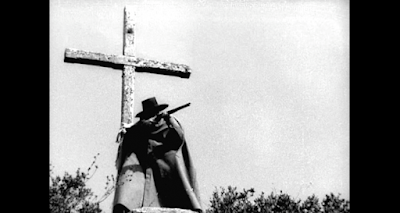A director spotlight can provide a focused ways to look at films. One can focus on certain signposts that identify the auteurial qualities of a director or one can discover a director’s diverse range. The latter is the case when watching the films of Joaquim Pedro de Andrade as part of an excellent Kino Lorber Blu-Ray package.
Prior to watching these films I had associated Joaquim Pedro de Andrade’s name with the deliriously creative and shape-shifting Macunaima (1969). That is why it is a real surprise to see Joaquim Pedro de Andrade’s range features a contemplative black and white film, engaging documentaries, a telenovela type of film and fiercely political films. The end result is a rich cinematic buffet to devour.
Cinema Novo
Joaquim Pedro de Andrade is a prominent director of Brazil’s Cinema Novo and as per this Indie Film Hustle article, his films would be classified under Phases 2 and 3. He made his fictional debut with O Padre e a Moça (The Priest and the Girl, 1965), a film that stands at an opposite end of the spectrum from Macunaima in style, story and rhythm. Macunaima dazzles with over-the-top colour and scenarios which rapidly shift gears from myth, folklore, societal and cultural commentary to intense politics. On the other end of the spectrum is The Priest and the Girl, a black and white film that is realistic and has a much more contemplative rhythm than that of the rapid pace of Joaquim Pedro’s other films. In addition, the film’s title and topic evokes Bresson while the town setting feels similar to the parched landscape of Glauber Rocha's films. Other than seeing Joaquim Pedro de Andrade’s name in the credits, there is no clue that The Priest and the Girl and Macunaima are directed by the same person.
The other Joaquim Pedro films bring an equal amount of surprise as well. His first directed feature, Garrincha: Joy of the People (1963), is a footage driven ode to Garrincha, one of the greatest soccer players to have ever graced the beautiful game. The short film Brasilia: Contradictions of a New City (1967) is an insightful newsreel short film that introduces the many head shaking contradictions of Brasilia. Then there is Conjugal Warfare (1975) which is a sex comedy that takes the essence of a telenovela/soap opera. This film feels at odds with the rest of Joaquim Pedro’s works in terms of execution, style and even topic. The Conspirators (1972) is a deeply layered political period film that details some of the complex debates, side deals, and negotiations that took as part of the Minas Gerais Conspiracy (1788-1789). Joaquim Pedro's final film, The Brazilwood Man (1982), is a playful film that challenges conventional film form and structure by using two actors (male, female) simultaneously to depict the masculine-feminine sides of Oswald de Andrade.
All the films in this Blu-Ray package are different and highlight why people make films. Sometimes, some directors have a burning desire to tell a story and sometimes, their hand is forced by financial realities which takes them in a different direction.
Other Reading








